Comprehensive Report: IKEA Australia Supply Chain and Sustainability
VerifiedAdded on 2022/08/14
|17
|4177
|13
Report
AI Summary
This report provides a comprehensive analysis of IKEA Australia's supply chain, focusing on its distribution structure. It examines the complexities faced by IKEA, including strategic mapping of distribution facilities, particularly the Marsden Park distribution center, and the need for additional facilities in populous areas. The report delves into supply chain risks, such as ineffective supplier relationship management, and highlights IKEA's sustainability initiatives, including its zero-waste policy. Recommendations are made to enhance zero-waste practices and source sustainable materials. The report also explores the impact of megatrends on the supply chain, the challenges of transitioning to a market-driven strategy, and the importance of managing political and market risks. The analysis includes a high-level map of the supply chain and evaluates supply chain complexity, risk management, and sustainability, offering insights into the future of IKEA's supply chain in Australia.
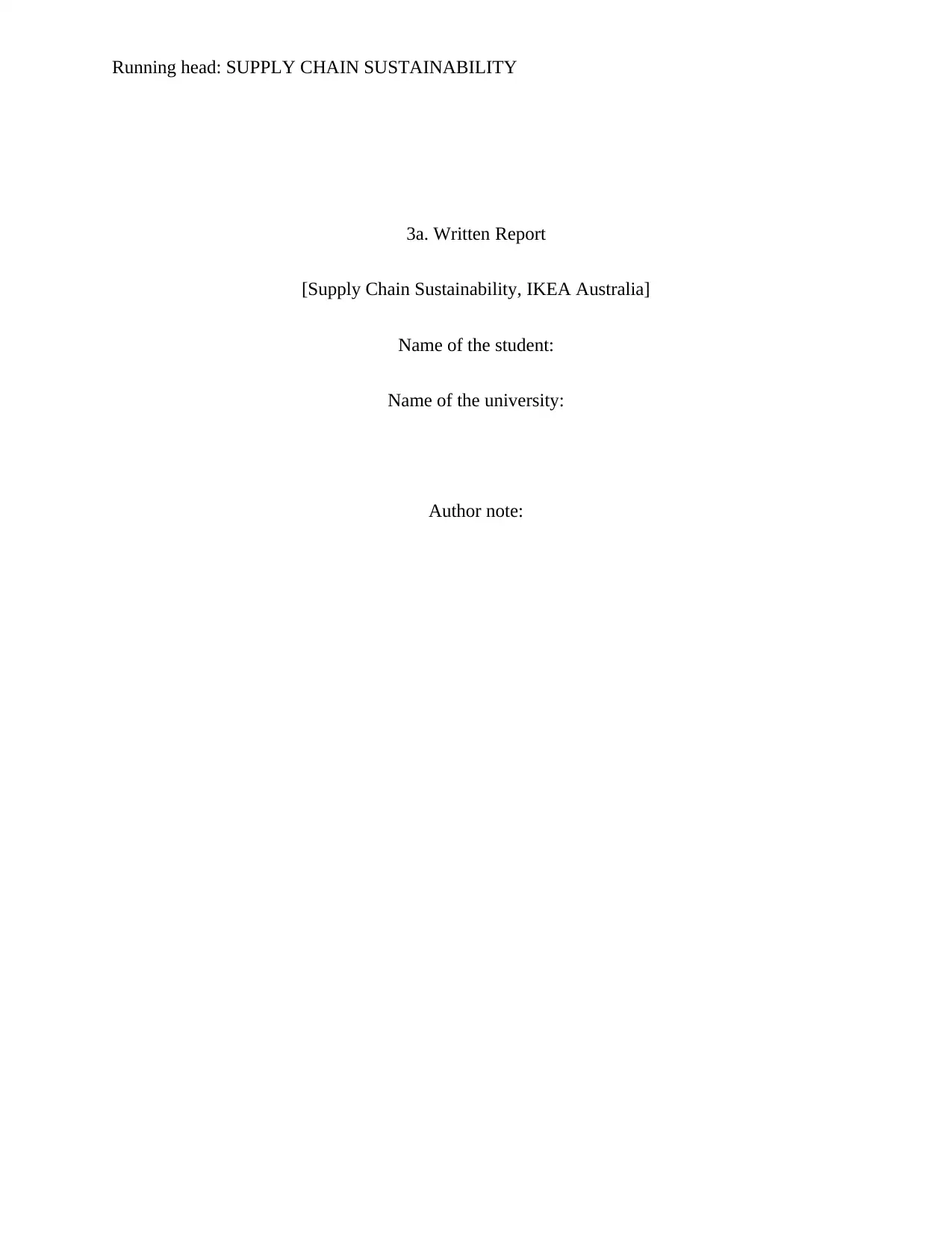
Running head: SUPPLY CHAIN SUSTAINABILITY
3a. Written Report
[Supply Chain Sustainability, IKEA Australia]
Name of the student:
Name of the university:
Author note:
3a. Written Report
[Supply Chain Sustainability, IKEA Australia]
Name of the student:
Name of the university:
Author note:
Paraphrase This Document
Need a fresh take? Get an instant paraphrase of this document with our AI Paraphraser
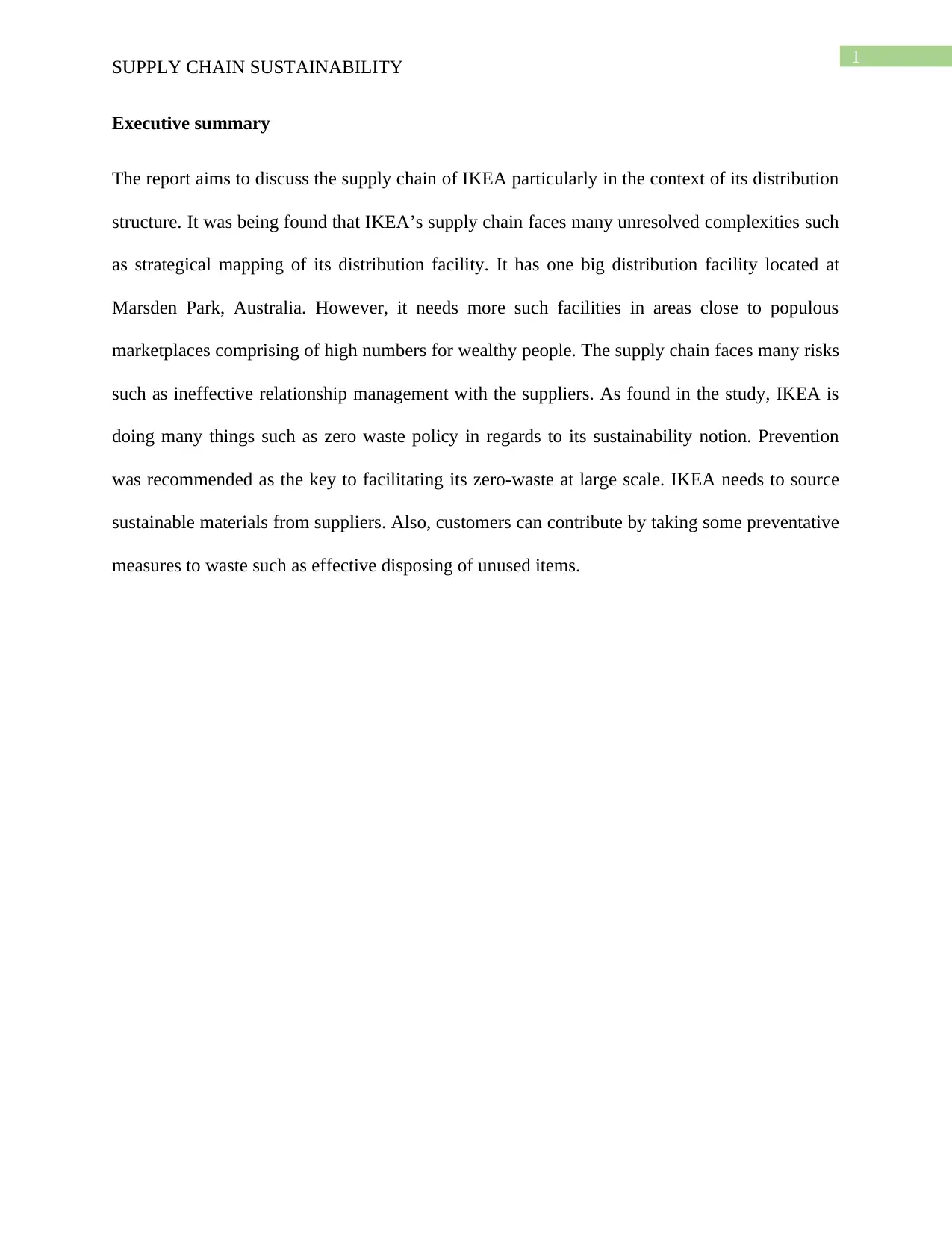
1
SUPPLY CHAIN SUSTAINABILITY
Executive summary
The report aims to discuss the supply chain of IKEA particularly in the context of its distribution
structure. It was being found that IKEA’s supply chain faces many unresolved complexities such
as strategical mapping of its distribution facility. It has one big distribution facility located at
Marsden Park, Australia. However, it needs more such facilities in areas close to populous
marketplaces comprising of high numbers for wealthy people. The supply chain faces many risks
such as ineffective relationship management with the suppliers. As found in the study, IKEA is
doing many things such as zero waste policy in regards to its sustainability notion. Prevention
was recommended as the key to facilitating its zero-waste at large scale. IKEA needs to source
sustainable materials from suppliers. Also, customers can contribute by taking some preventative
measures to waste such as effective disposing of unused items.
SUPPLY CHAIN SUSTAINABILITY
Executive summary
The report aims to discuss the supply chain of IKEA particularly in the context of its distribution
structure. It was being found that IKEA’s supply chain faces many unresolved complexities such
as strategical mapping of its distribution facility. It has one big distribution facility located at
Marsden Park, Australia. However, it needs more such facilities in areas close to populous
marketplaces comprising of high numbers for wealthy people. The supply chain faces many risks
such as ineffective relationship management with the suppliers. As found in the study, IKEA is
doing many things such as zero waste policy in regards to its sustainability notion. Prevention
was recommended as the key to facilitating its zero-waste at large scale. IKEA needs to source
sustainable materials from suppliers. Also, customers can contribute by taking some preventative
measures to waste such as effective disposing of unused items.
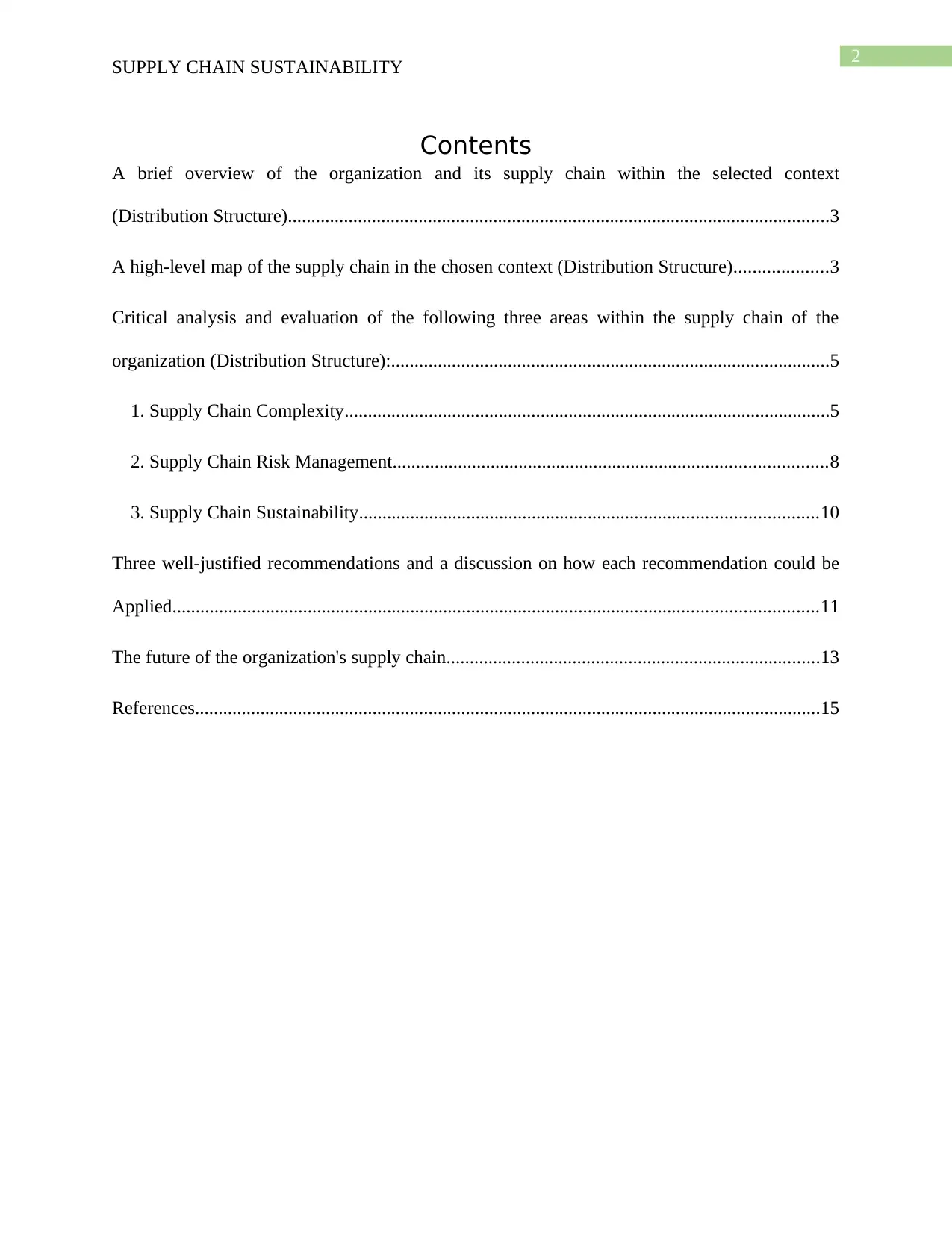
2
SUPPLY CHAIN SUSTAINABILITY
Contents
A brief overview of the organization and its supply chain within the selected context
(Distribution Structure)....................................................................................................................3
A high-level map of the supply chain in the chosen context (Distribution Structure)....................3
Critical analysis and evaluation of the following three areas within the supply chain of the
organization (Distribution Structure):..............................................................................................5
1. Supply Chain Complexity........................................................................................................5
2. Supply Chain Risk Management.............................................................................................8
3. Supply Chain Sustainability..................................................................................................10
Three well-justified recommendations and a discussion on how each recommendation could be
Applied..........................................................................................................................................11
The future of the organization's supply chain................................................................................13
References......................................................................................................................................15
SUPPLY CHAIN SUSTAINABILITY
Contents
A brief overview of the organization and its supply chain within the selected context
(Distribution Structure)....................................................................................................................3
A high-level map of the supply chain in the chosen context (Distribution Structure)....................3
Critical analysis and evaluation of the following three areas within the supply chain of the
organization (Distribution Structure):..............................................................................................5
1. Supply Chain Complexity........................................................................................................5
2. Supply Chain Risk Management.............................................................................................8
3. Supply Chain Sustainability..................................................................................................10
Three well-justified recommendations and a discussion on how each recommendation could be
Applied..........................................................................................................................................11
The future of the organization's supply chain................................................................................13
References......................................................................................................................................15
⊘ This is a preview!⊘
Do you want full access?
Subscribe today to unlock all pages.

Trusted by 1+ million students worldwide
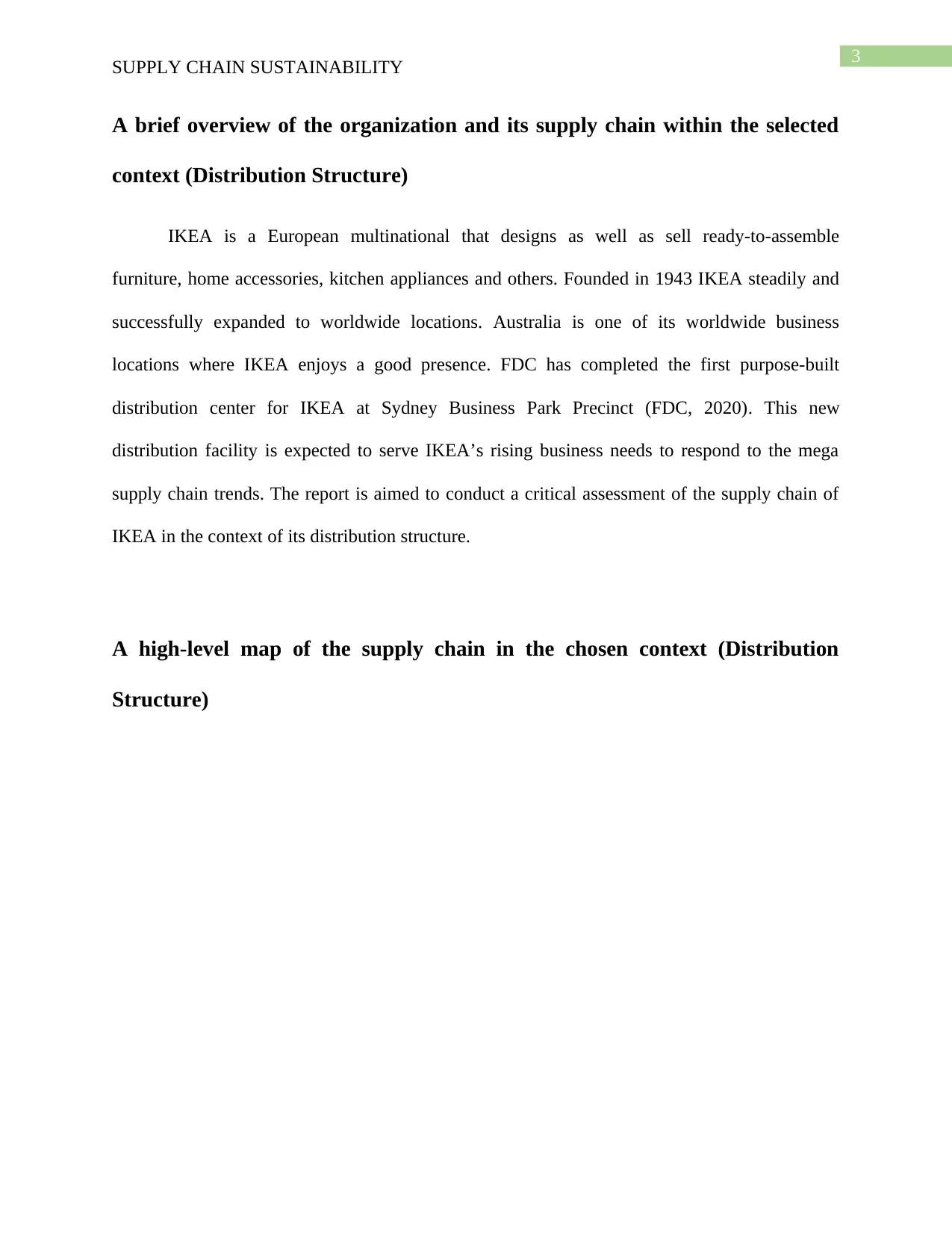
3
SUPPLY CHAIN SUSTAINABILITY
A brief overview of the organization and its supply chain within the selected
context (Distribution Structure)
IKEA is a European multinational that designs as well as sell ready-to-assemble
furniture, home accessories, kitchen appliances and others. Founded in 1943 IKEA steadily and
successfully expanded to worldwide locations. Australia is one of its worldwide business
locations where IKEA enjoys a good presence. FDC has completed the first purpose-built
distribution center for IKEA at Sydney Business Park Precinct (FDC, 2020). This new
distribution facility is expected to serve IKEA’s rising business needs to respond to the mega
supply chain trends. The report is aimed to conduct a critical assessment of the supply chain of
IKEA in the context of its distribution structure.
A high-level map of the supply chain in the chosen context (Distribution
Structure)
SUPPLY CHAIN SUSTAINABILITY
A brief overview of the organization and its supply chain within the selected
context (Distribution Structure)
IKEA is a European multinational that designs as well as sell ready-to-assemble
furniture, home accessories, kitchen appliances and others. Founded in 1943 IKEA steadily and
successfully expanded to worldwide locations. Australia is one of its worldwide business
locations where IKEA enjoys a good presence. FDC has completed the first purpose-built
distribution center for IKEA at Sydney Business Park Precinct (FDC, 2020). This new
distribution facility is expected to serve IKEA’s rising business needs to respond to the mega
supply chain trends. The report is aimed to conduct a critical assessment of the supply chain of
IKEA in the context of its distribution structure.
A high-level map of the supply chain in the chosen context (Distribution
Structure)
Paraphrase This Document
Need a fresh take? Get an instant paraphrase of this document with our AI Paraphraser
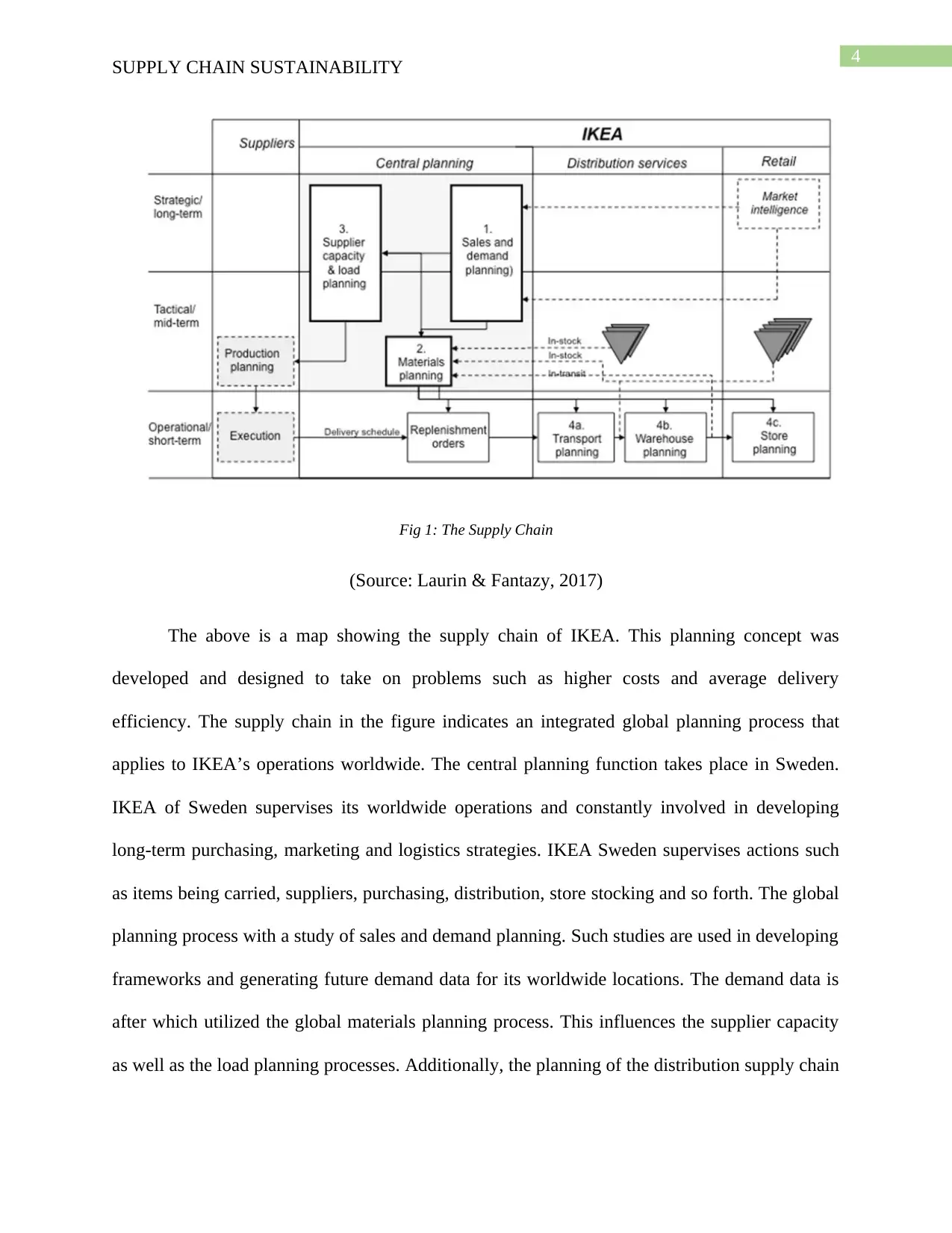
4
SUPPLY CHAIN SUSTAINABILITY
Fig 1: The Supply Chain
(Source: Laurin & Fantazy, 2017)
The above is a map showing the supply chain of IKEA. This planning concept was
developed and designed to take on problems such as higher costs and average delivery
efficiency. The supply chain in the figure indicates an integrated global planning process that
applies to IKEA’s operations worldwide. The central planning function takes place in Sweden.
IKEA of Sweden supervises its worldwide operations and constantly involved in developing
long-term purchasing, marketing and logistics strategies. IKEA Sweden supervises actions such
as items being carried, suppliers, purchasing, distribution, store stocking and so forth. The global
planning process with a study of sales and demand planning. Such studies are used in developing
frameworks and generating future demand data for its worldwide locations. The demand data is
after which utilized the global materials planning process. This influences the supplier capacity
as well as the load planning processes. Additionally, the planning of the distribution supply chain
SUPPLY CHAIN SUSTAINABILITY
Fig 1: The Supply Chain
(Source: Laurin & Fantazy, 2017)
The above is a map showing the supply chain of IKEA. This planning concept was
developed and designed to take on problems such as higher costs and average delivery
efficiency. The supply chain in the figure indicates an integrated global planning process that
applies to IKEA’s operations worldwide. The central planning function takes place in Sweden.
IKEA of Sweden supervises its worldwide operations and constantly involved in developing
long-term purchasing, marketing and logistics strategies. IKEA Sweden supervises actions such
as items being carried, suppliers, purchasing, distribution, store stocking and so forth. The global
planning process with a study of sales and demand planning. Such studies are used in developing
frameworks and generating future demand data for its worldwide locations. The demand data is
after which utilized the global materials planning process. This influences the supplier capacity
as well as the load planning processes. Additionally, the planning of the distribution supply chain
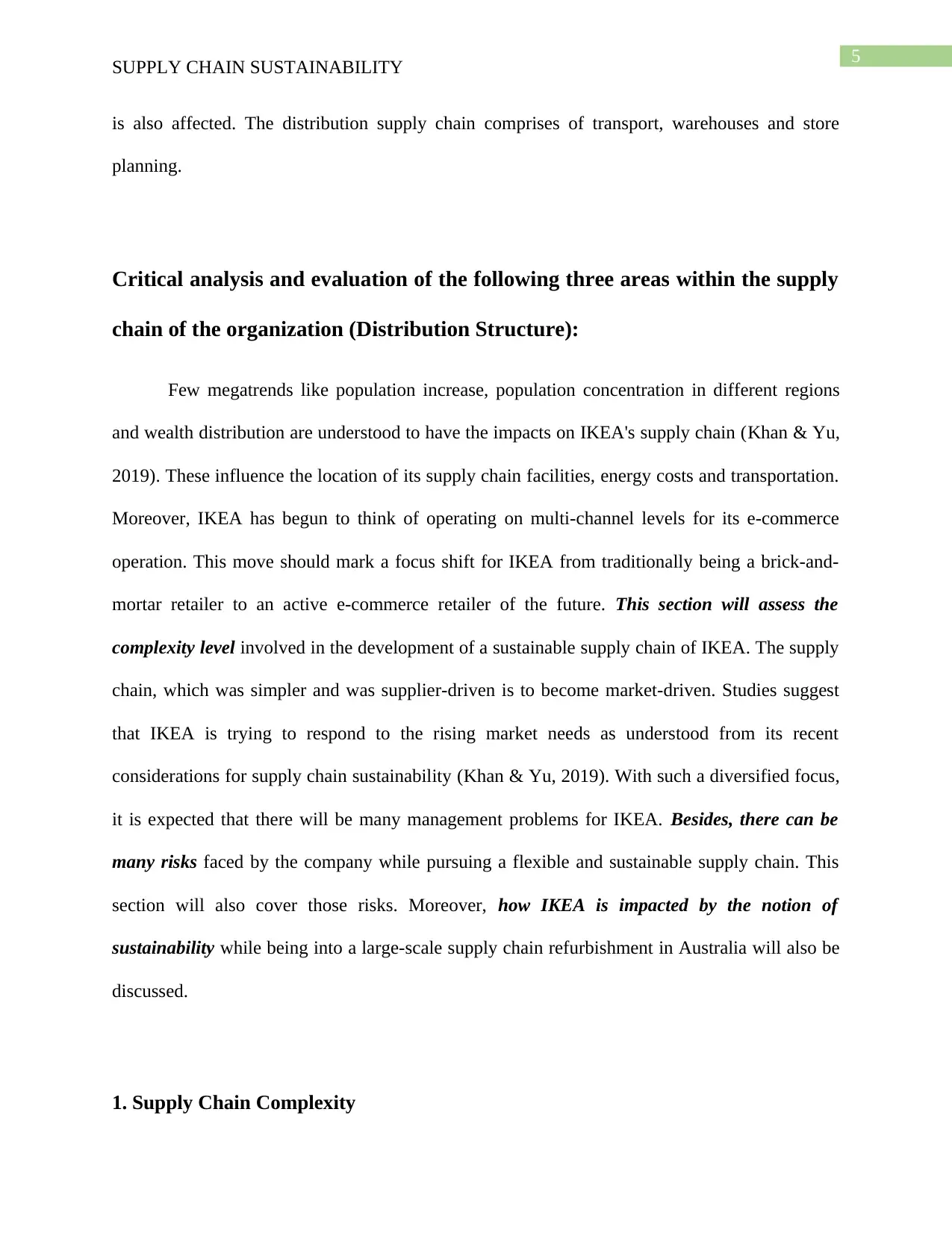
5
SUPPLY CHAIN SUSTAINABILITY
is also affected. The distribution supply chain comprises of transport, warehouses and store
planning.
Critical analysis and evaluation of the following three areas within the supply
chain of the organization (Distribution Structure):
Few megatrends like population increase, population concentration in different regions
and wealth distribution are understood to have the impacts on IKEA's supply chain (Khan & Yu,
2019). These influence the location of its supply chain facilities, energy costs and transportation.
Moreover, IKEA has begun to think of operating on multi-channel levels for its e-commerce
operation. This move should mark a focus shift for IKEA from traditionally being a brick-and-
mortar retailer to an active e-commerce retailer of the future. This section will assess the
complexity level involved in the development of a sustainable supply chain of IKEA. The supply
chain, which was simpler and was supplier-driven is to become market-driven. Studies suggest
that IKEA is trying to respond to the rising market needs as understood from its recent
considerations for supply chain sustainability (Khan & Yu, 2019). With such a diversified focus,
it is expected that there will be many management problems for IKEA. Besides, there can be
many risks faced by the company while pursuing a flexible and sustainable supply chain. This
section will also cover those risks. Moreover, how IKEA is impacted by the notion of
sustainability while being into a large-scale supply chain refurbishment in Australia will also be
discussed.
1. Supply Chain Complexity
SUPPLY CHAIN SUSTAINABILITY
is also affected. The distribution supply chain comprises of transport, warehouses and store
planning.
Critical analysis and evaluation of the following three areas within the supply
chain of the organization (Distribution Structure):
Few megatrends like population increase, population concentration in different regions
and wealth distribution are understood to have the impacts on IKEA's supply chain (Khan & Yu,
2019). These influence the location of its supply chain facilities, energy costs and transportation.
Moreover, IKEA has begun to think of operating on multi-channel levels for its e-commerce
operation. This move should mark a focus shift for IKEA from traditionally being a brick-and-
mortar retailer to an active e-commerce retailer of the future. This section will assess the
complexity level involved in the development of a sustainable supply chain of IKEA. The supply
chain, which was simpler and was supplier-driven is to become market-driven. Studies suggest
that IKEA is trying to respond to the rising market needs as understood from its recent
considerations for supply chain sustainability (Khan & Yu, 2019). With such a diversified focus,
it is expected that there will be many management problems for IKEA. Besides, there can be
many risks faced by the company while pursuing a flexible and sustainable supply chain. This
section will also cover those risks. Moreover, how IKEA is impacted by the notion of
sustainability while being into a large-scale supply chain refurbishment in Australia will also be
discussed.
1. Supply Chain Complexity
⊘ This is a preview!⊘
Do you want full access?
Subscribe today to unlock all pages.

Trusted by 1+ million students worldwide
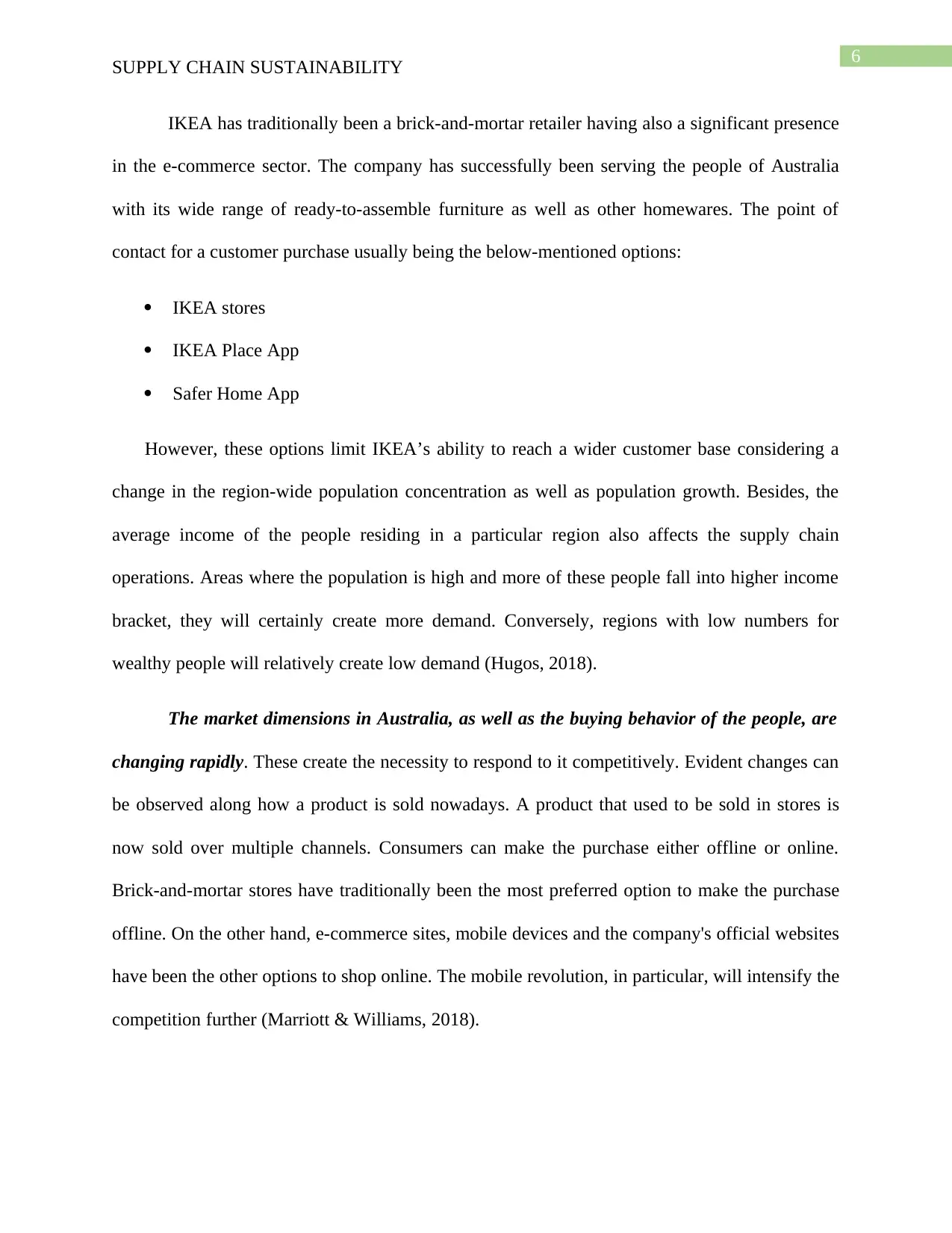
6
SUPPLY CHAIN SUSTAINABILITY
IKEA has traditionally been a brick-and-mortar retailer having also a significant presence
in the e-commerce sector. The company has successfully been serving the people of Australia
with its wide range of ready-to-assemble furniture as well as other homewares. The point of
contact for a customer purchase usually being the below-mentioned options:
IKEA stores
IKEA Place App
Safer Home App
However, these options limit IKEA’s ability to reach a wider customer base considering a
change in the region-wide population concentration as well as population growth. Besides, the
average income of the people residing in a particular region also affects the supply chain
operations. Areas where the population is high and more of these people fall into higher income
bracket, they will certainly create more demand. Conversely, regions with low numbers for
wealthy people will relatively create low demand (Hugos, 2018).
The market dimensions in Australia, as well as the buying behavior of the people, are
changing rapidly. These create the necessity to respond to it competitively. Evident changes can
be observed along how a product is sold nowadays. A product that used to be sold in stores is
now sold over multiple channels. Consumers can make the purchase either offline or online.
Brick-and-mortar stores have traditionally been the most preferred option to make the purchase
offline. On the other hand, e-commerce sites, mobile devices and the company's official websites
have been the other options to shop online. The mobile revolution, in particular, will intensify the
competition further (Marriott & Williams, 2018).
SUPPLY CHAIN SUSTAINABILITY
IKEA has traditionally been a brick-and-mortar retailer having also a significant presence
in the e-commerce sector. The company has successfully been serving the people of Australia
with its wide range of ready-to-assemble furniture as well as other homewares. The point of
contact for a customer purchase usually being the below-mentioned options:
IKEA stores
IKEA Place App
Safer Home App
However, these options limit IKEA’s ability to reach a wider customer base considering a
change in the region-wide population concentration as well as population growth. Besides, the
average income of the people residing in a particular region also affects the supply chain
operations. Areas where the population is high and more of these people fall into higher income
bracket, they will certainly create more demand. Conversely, regions with low numbers for
wealthy people will relatively create low demand (Hugos, 2018).
The market dimensions in Australia, as well as the buying behavior of the people, are
changing rapidly. These create the necessity to respond to it competitively. Evident changes can
be observed along how a product is sold nowadays. A product that used to be sold in stores is
now sold over multiple channels. Consumers can make the purchase either offline or online.
Brick-and-mortar stores have traditionally been the most preferred option to make the purchase
offline. On the other hand, e-commerce sites, mobile devices and the company's official websites
have been the other options to shop online. The mobile revolution, in particular, will intensify the
competition further (Marriott & Williams, 2018).
Paraphrase This Document
Need a fresh take? Get an instant paraphrase of this document with our AI Paraphraser
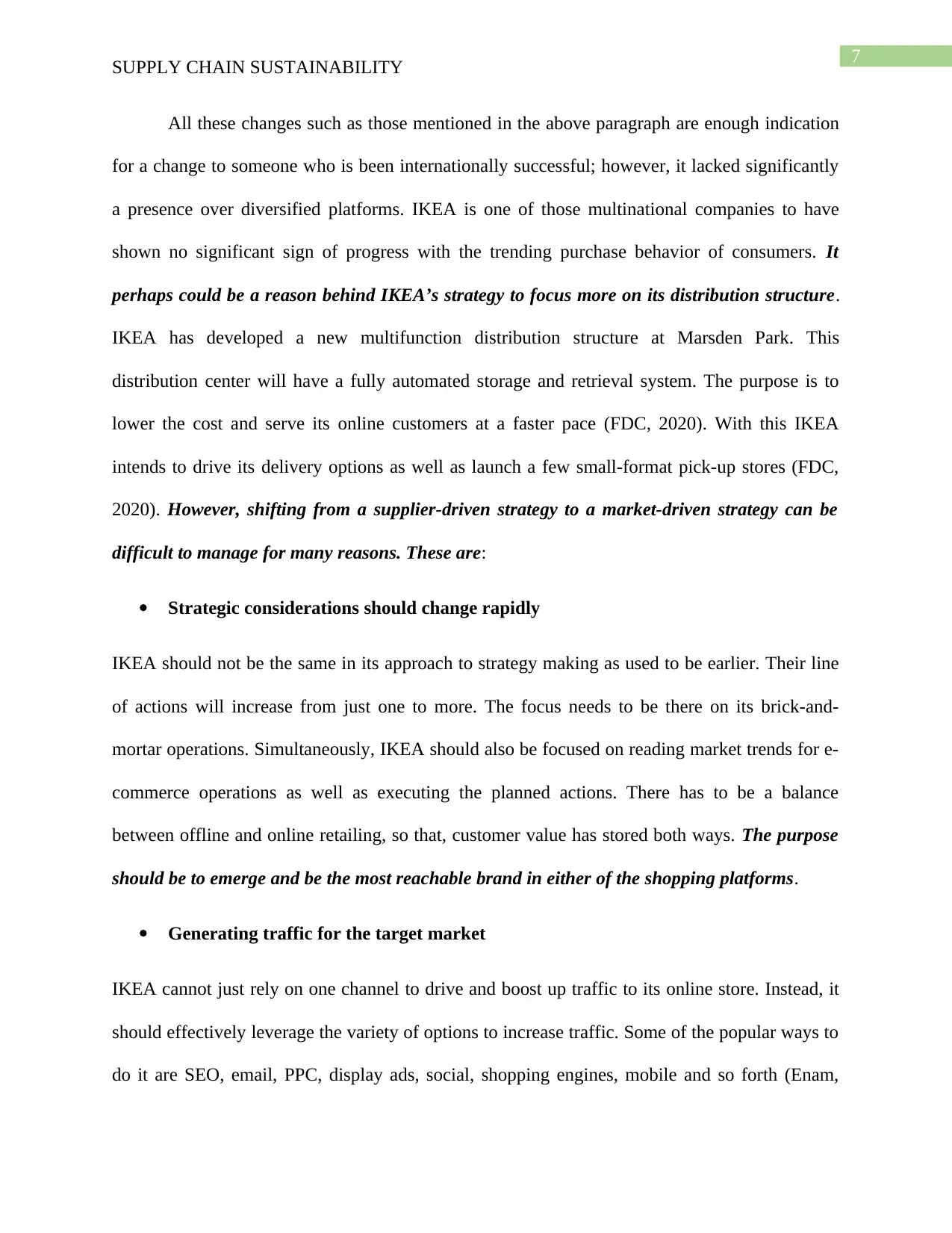
7
SUPPLY CHAIN SUSTAINABILITY
All these changes such as those mentioned in the above paragraph are enough indication
for a change to someone who is been internationally successful; however, it lacked significantly
a presence over diversified platforms. IKEA is one of those multinational companies to have
shown no significant sign of progress with the trending purchase behavior of consumers. It
perhaps could be a reason behind IKEA’s strategy to focus more on its distribution structure.
IKEA has developed a new multifunction distribution structure at Marsden Park. This
distribution center will have a fully automated storage and retrieval system. The purpose is to
lower the cost and serve its online customers at a faster pace (FDC, 2020). With this IKEA
intends to drive its delivery options as well as launch a few small-format pick-up stores (FDC,
2020). However, shifting from a supplier-driven strategy to a market-driven strategy can be
difficult to manage for many reasons. These are:
Strategic considerations should change rapidly
IKEA should not be the same in its approach to strategy making as used to be earlier. Their line
of actions will increase from just one to more. The focus needs to be there on its brick-and-
mortar operations. Simultaneously, IKEA should also be focused on reading market trends for e-
commerce operations as well as executing the planned actions. There has to be a balance
between offline and online retailing, so that, customer value has stored both ways. The purpose
should be to emerge and be the most reachable brand in either of the shopping platforms.
Generating traffic for the target market
IKEA cannot just rely on one channel to drive and boost up traffic to its online store. Instead, it
should effectively leverage the variety of options to increase traffic. Some of the popular ways to
do it are SEO, email, PPC, display ads, social, shopping engines, mobile and so forth (Enam,
SUPPLY CHAIN SUSTAINABILITY
All these changes such as those mentioned in the above paragraph are enough indication
for a change to someone who is been internationally successful; however, it lacked significantly
a presence over diversified platforms. IKEA is one of those multinational companies to have
shown no significant sign of progress with the trending purchase behavior of consumers. It
perhaps could be a reason behind IKEA’s strategy to focus more on its distribution structure.
IKEA has developed a new multifunction distribution structure at Marsden Park. This
distribution center will have a fully automated storage and retrieval system. The purpose is to
lower the cost and serve its online customers at a faster pace (FDC, 2020). With this IKEA
intends to drive its delivery options as well as launch a few small-format pick-up stores (FDC,
2020). However, shifting from a supplier-driven strategy to a market-driven strategy can be
difficult to manage for many reasons. These are:
Strategic considerations should change rapidly
IKEA should not be the same in its approach to strategy making as used to be earlier. Their line
of actions will increase from just one to more. The focus needs to be there on its brick-and-
mortar operations. Simultaneously, IKEA should also be focused on reading market trends for e-
commerce operations as well as executing the planned actions. There has to be a balance
between offline and online retailing, so that, customer value has stored both ways. The purpose
should be to emerge and be the most reachable brand in either of the shopping platforms.
Generating traffic for the target market
IKEA cannot just rely on one channel to drive and boost up traffic to its online store. Instead, it
should effectively leverage the variety of options to increase traffic. Some of the popular ways to
do it are SEO, email, PPC, display ads, social, shopping engines, mobile and so forth (Enam,
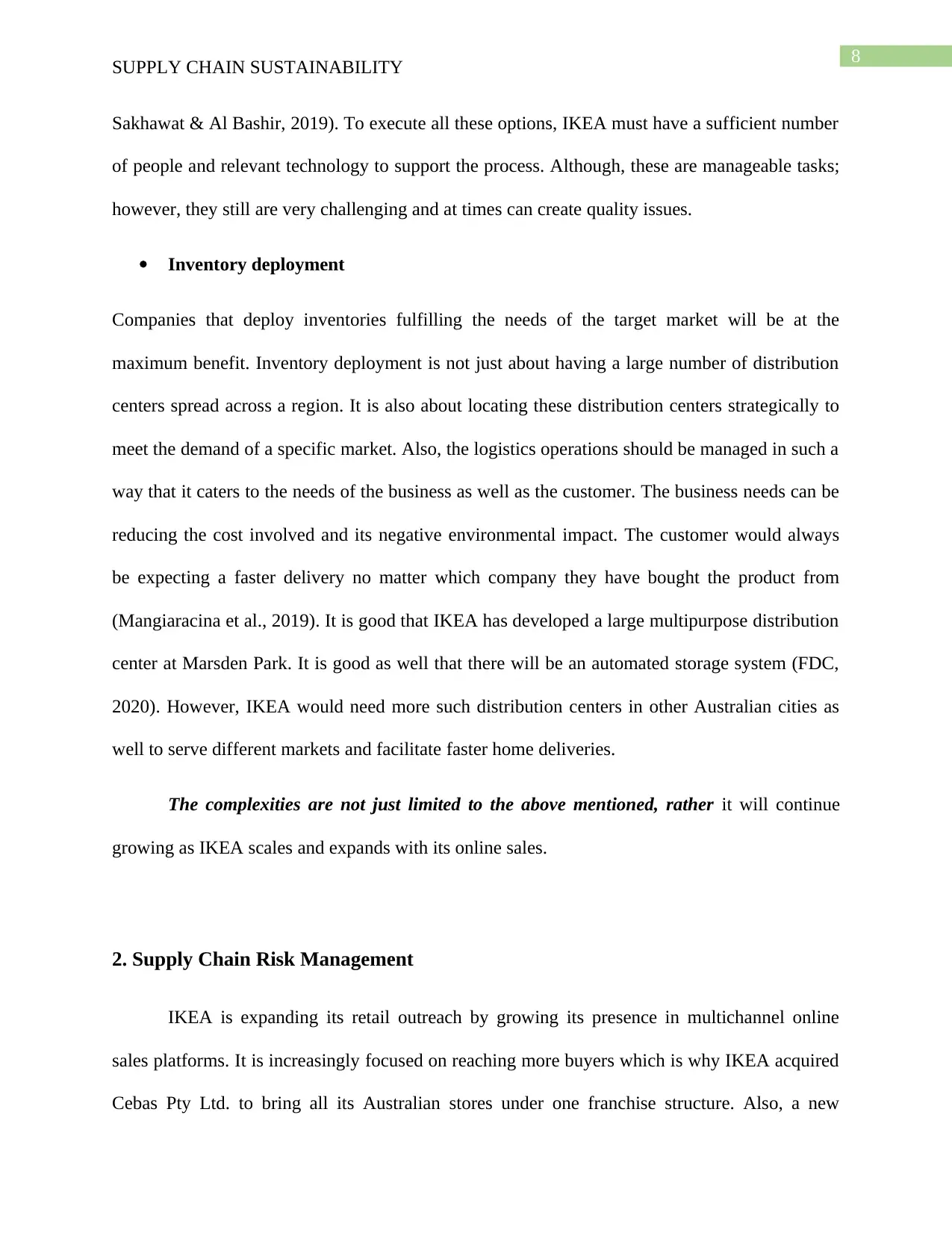
8
SUPPLY CHAIN SUSTAINABILITY
Sakhawat & Al Bashir, 2019). To execute all these options, IKEA must have a sufficient number
of people and relevant technology to support the process. Although, these are manageable tasks;
however, they still are very challenging and at times can create quality issues.
Inventory deployment
Companies that deploy inventories fulfilling the needs of the target market will be at the
maximum benefit. Inventory deployment is not just about having a large number of distribution
centers spread across a region. It is also about locating these distribution centers strategically to
meet the demand of a specific market. Also, the logistics operations should be managed in such a
way that it caters to the needs of the business as well as the customer. The business needs can be
reducing the cost involved and its negative environmental impact. The customer would always
be expecting a faster delivery no matter which company they have bought the product from
(Mangiaracina et al., 2019). It is good that IKEA has developed a large multipurpose distribution
center at Marsden Park. It is good as well that there will be an automated storage system (FDC,
2020). However, IKEA would need more such distribution centers in other Australian cities as
well to serve different markets and facilitate faster home deliveries.
The complexities are not just limited to the above mentioned, rather it will continue
growing as IKEA scales and expands with its online sales.
2. Supply Chain Risk Management
IKEA is expanding its retail outreach by growing its presence in multichannel online
sales platforms. It is increasingly focused on reaching more buyers which is why IKEA acquired
Cebas Pty Ltd. to bring all its Australian stores under one franchise structure. Also, a new
SUPPLY CHAIN SUSTAINABILITY
Sakhawat & Al Bashir, 2019). To execute all these options, IKEA must have a sufficient number
of people and relevant technology to support the process. Although, these are manageable tasks;
however, they still are very challenging and at times can create quality issues.
Inventory deployment
Companies that deploy inventories fulfilling the needs of the target market will be at the
maximum benefit. Inventory deployment is not just about having a large number of distribution
centers spread across a region. It is also about locating these distribution centers strategically to
meet the demand of a specific market. Also, the logistics operations should be managed in such a
way that it caters to the needs of the business as well as the customer. The business needs can be
reducing the cost involved and its negative environmental impact. The customer would always
be expecting a faster delivery no matter which company they have bought the product from
(Mangiaracina et al., 2019). It is good that IKEA has developed a large multipurpose distribution
center at Marsden Park. It is good as well that there will be an automated storage system (FDC,
2020). However, IKEA would need more such distribution centers in other Australian cities as
well to serve different markets and facilitate faster home deliveries.
The complexities are not just limited to the above mentioned, rather it will continue
growing as IKEA scales and expands with its online sales.
2. Supply Chain Risk Management
IKEA is expanding its retail outreach by growing its presence in multichannel online
sales platforms. It is increasingly focused on reaching more buyers which is why IKEA acquired
Cebas Pty Ltd. to bring all its Australian stores under one franchise structure. Also, a new
⊘ This is a preview!⊘
Do you want full access?
Subscribe today to unlock all pages.

Trusted by 1+ million students worldwide
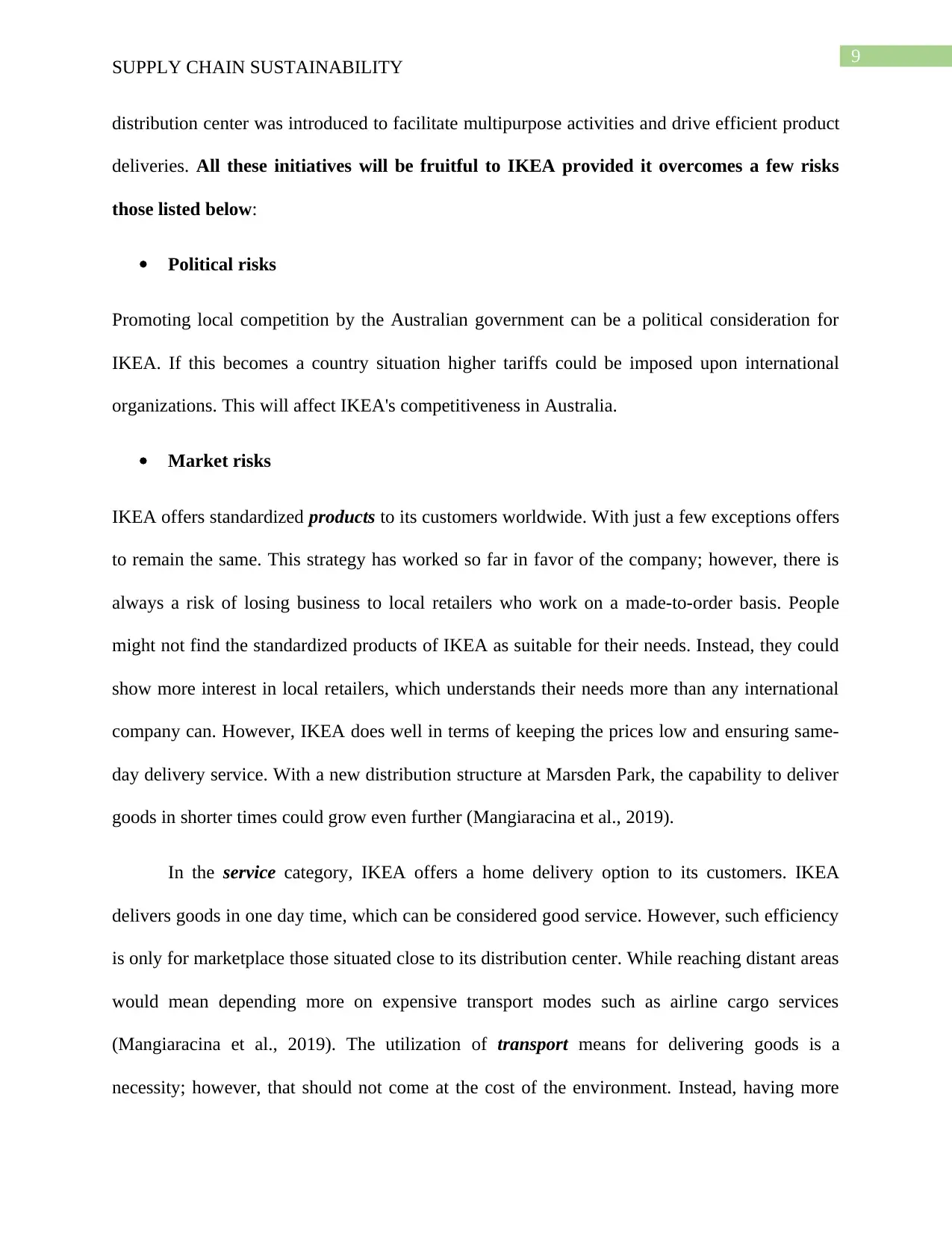
9
SUPPLY CHAIN SUSTAINABILITY
distribution center was introduced to facilitate multipurpose activities and drive efficient product
deliveries. All these initiatives will be fruitful to IKEA provided it overcomes a few risks
those listed below:
Political risks
Promoting local competition by the Australian government can be a political consideration for
IKEA. If this becomes a country situation higher tariffs could be imposed upon international
organizations. This will affect IKEA's competitiveness in Australia.
Market risks
IKEA offers standardized products to its customers worldwide. With just a few exceptions offers
to remain the same. This strategy has worked so far in favor of the company; however, there is
always a risk of losing business to local retailers who work on a made-to-order basis. People
might not find the standardized products of IKEA as suitable for their needs. Instead, they could
show more interest in local retailers, which understands their needs more than any international
company can. However, IKEA does well in terms of keeping the prices low and ensuring same-
day delivery service. With a new distribution structure at Marsden Park, the capability to deliver
goods in shorter times could grow even further (Mangiaracina et al., 2019).
In the service category, IKEA offers a home delivery option to its customers. IKEA
delivers goods in one day time, which can be considered good service. However, such efficiency
is only for marketplace those situated close to its distribution center. While reaching distant areas
would mean depending more on expensive transport modes such as airline cargo services
(Mangiaracina et al., 2019). The utilization of transport means for delivering goods is a
necessity; however, that should not come at the cost of the environment. Instead, having more
SUPPLY CHAIN SUSTAINABILITY
distribution center was introduced to facilitate multipurpose activities and drive efficient product
deliveries. All these initiatives will be fruitful to IKEA provided it overcomes a few risks
those listed below:
Political risks
Promoting local competition by the Australian government can be a political consideration for
IKEA. If this becomes a country situation higher tariffs could be imposed upon international
organizations. This will affect IKEA's competitiveness in Australia.
Market risks
IKEA offers standardized products to its customers worldwide. With just a few exceptions offers
to remain the same. This strategy has worked so far in favor of the company; however, there is
always a risk of losing business to local retailers who work on a made-to-order basis. People
might not find the standardized products of IKEA as suitable for their needs. Instead, they could
show more interest in local retailers, which understands their needs more than any international
company can. However, IKEA does well in terms of keeping the prices low and ensuring same-
day delivery service. With a new distribution structure at Marsden Park, the capability to deliver
goods in shorter times could grow even further (Mangiaracina et al., 2019).
In the service category, IKEA offers a home delivery option to its customers. IKEA
delivers goods in one day time, which can be considered good service. However, such efficiency
is only for marketplace those situated close to its distribution center. While reaching distant areas
would mean depending more on expensive transport modes such as airline cargo services
(Mangiaracina et al., 2019). The utilization of transport means for delivering goods is a
necessity; however, that should not come at the cost of the environment. Instead, having more
Paraphrase This Document
Need a fresh take? Get an instant paraphrase of this document with our AI Paraphraser
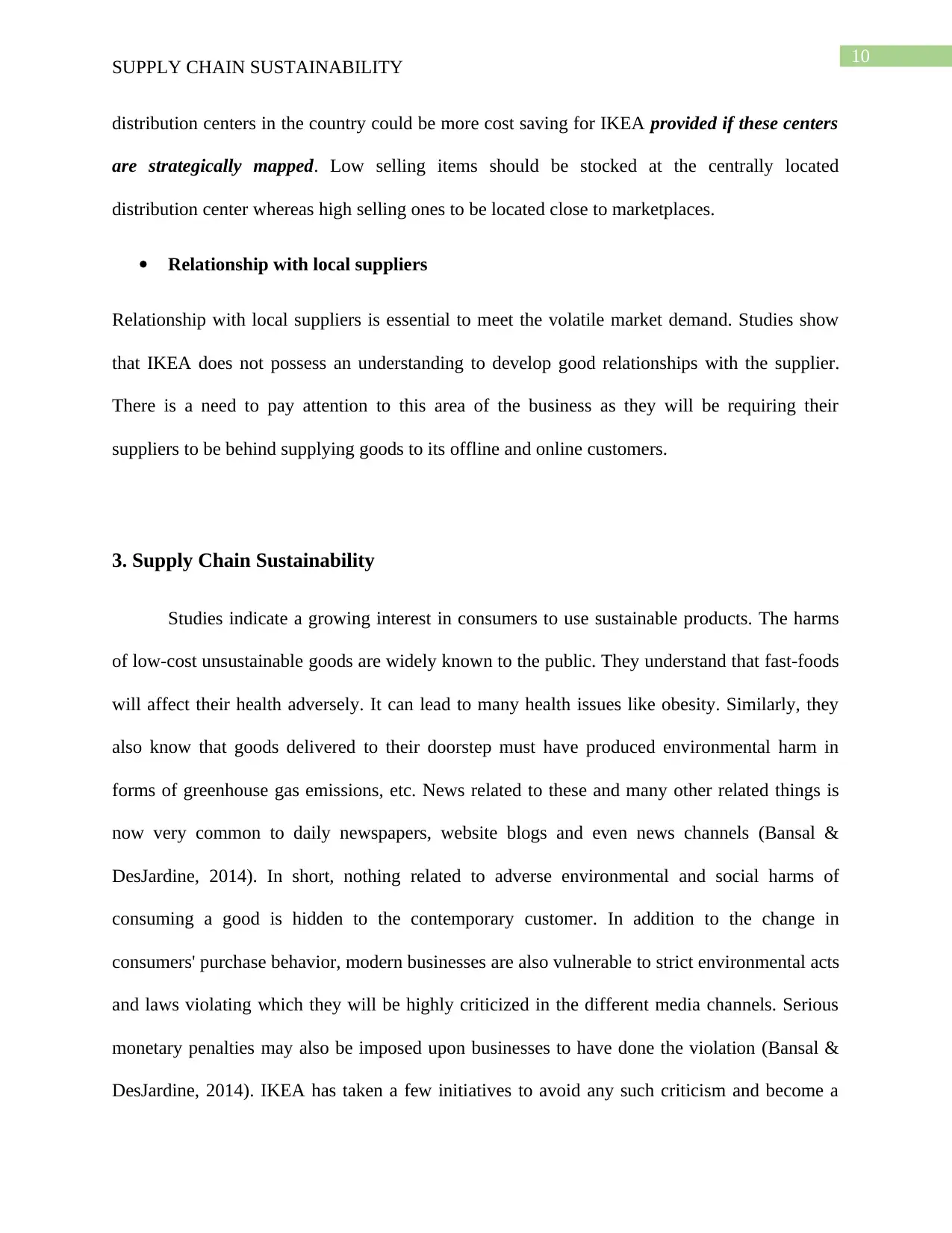
10
SUPPLY CHAIN SUSTAINABILITY
distribution centers in the country could be more cost saving for IKEA provided if these centers
are strategically mapped. Low selling items should be stocked at the centrally located
distribution center whereas high selling ones to be located close to marketplaces.
Relationship with local suppliers
Relationship with local suppliers is essential to meet the volatile market demand. Studies show
that IKEA does not possess an understanding to develop good relationships with the supplier.
There is a need to pay attention to this area of the business as they will be requiring their
suppliers to be behind supplying goods to its offline and online customers.
3. Supply Chain Sustainability
Studies indicate a growing interest in consumers to use sustainable products. The harms
of low-cost unsustainable goods are widely known to the public. They understand that fast-foods
will affect their health adversely. It can lead to many health issues like obesity. Similarly, they
also know that goods delivered to their doorstep must have produced environmental harm in
forms of greenhouse gas emissions, etc. News related to these and many other related things is
now very common to daily newspapers, website blogs and even news channels (Bansal &
DesJardine, 2014). In short, nothing related to adverse environmental and social harms of
consuming a good is hidden to the contemporary customer. In addition to the change in
consumers' purchase behavior, modern businesses are also vulnerable to strict environmental acts
and laws violating which they will be highly criticized in the different media channels. Serious
monetary penalties may also be imposed upon businesses to have done the violation (Bansal &
DesJardine, 2014). IKEA has taken a few initiatives to avoid any such criticism and become a
SUPPLY CHAIN SUSTAINABILITY
distribution centers in the country could be more cost saving for IKEA provided if these centers
are strategically mapped. Low selling items should be stocked at the centrally located
distribution center whereas high selling ones to be located close to marketplaces.
Relationship with local suppliers
Relationship with local suppliers is essential to meet the volatile market demand. Studies show
that IKEA does not possess an understanding to develop good relationships with the supplier.
There is a need to pay attention to this area of the business as they will be requiring their
suppliers to be behind supplying goods to its offline and online customers.
3. Supply Chain Sustainability
Studies indicate a growing interest in consumers to use sustainable products. The harms
of low-cost unsustainable goods are widely known to the public. They understand that fast-foods
will affect their health adversely. It can lead to many health issues like obesity. Similarly, they
also know that goods delivered to their doorstep must have produced environmental harm in
forms of greenhouse gas emissions, etc. News related to these and many other related things is
now very common to daily newspapers, website blogs and even news channels (Bansal &
DesJardine, 2014). In short, nothing related to adverse environmental and social harms of
consuming a good is hidden to the contemporary customer. In addition to the change in
consumers' purchase behavior, modern businesses are also vulnerable to strict environmental acts
and laws violating which they will be highly criticized in the different media channels. Serious
monetary penalties may also be imposed upon businesses to have done the violation (Bansal &
DesJardine, 2014). IKEA has taken a few initiatives to avoid any such criticism and become a
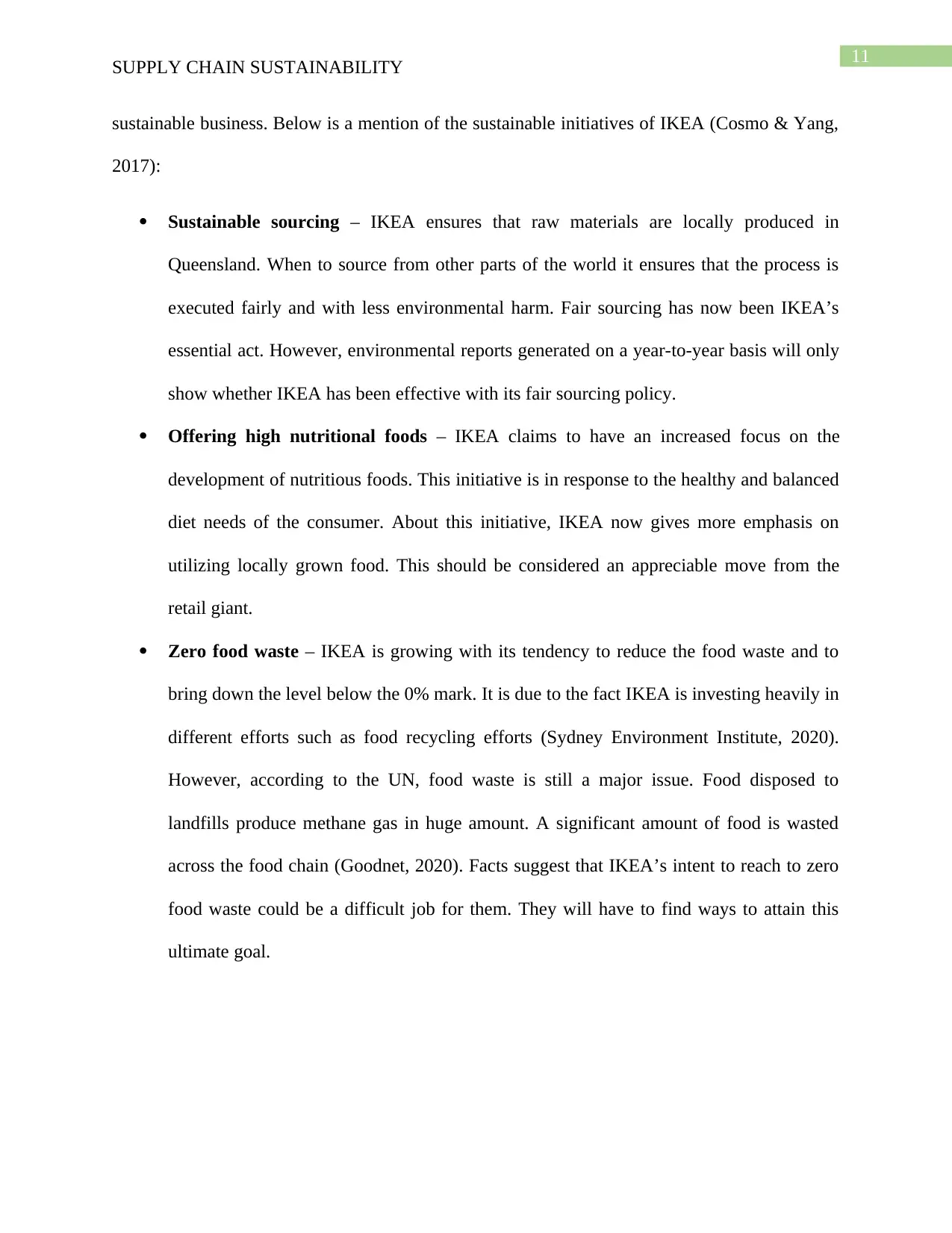
11
SUPPLY CHAIN SUSTAINABILITY
sustainable business. Below is a mention of the sustainable initiatives of IKEA (Cosmo & Yang,
2017):
Sustainable sourcing – IKEA ensures that raw materials are locally produced in
Queensland. When to source from other parts of the world it ensures that the process is
executed fairly and with less environmental harm. Fair sourcing has now been IKEA’s
essential act. However, environmental reports generated on a year-to-year basis will only
show whether IKEA has been effective with its fair sourcing policy.
Offering high nutritional foods – IKEA claims to have an increased focus on the
development of nutritious foods. This initiative is in response to the healthy and balanced
diet needs of the consumer. About this initiative, IKEA now gives more emphasis on
utilizing locally grown food. This should be considered an appreciable move from the
retail giant.
Zero food waste – IKEA is growing with its tendency to reduce the food waste and to
bring down the level below the 0% mark. It is due to the fact IKEA is investing heavily in
different efforts such as food recycling efforts (Sydney Environment Institute, 2020).
However, according to the UN, food waste is still a major issue. Food disposed to
landfills produce methane gas in huge amount. A significant amount of food is wasted
across the food chain (Goodnet, 2020). Facts suggest that IKEA’s intent to reach to zero
food waste could be a difficult job for them. They will have to find ways to attain this
ultimate goal.
SUPPLY CHAIN SUSTAINABILITY
sustainable business. Below is a mention of the sustainable initiatives of IKEA (Cosmo & Yang,
2017):
Sustainable sourcing – IKEA ensures that raw materials are locally produced in
Queensland. When to source from other parts of the world it ensures that the process is
executed fairly and with less environmental harm. Fair sourcing has now been IKEA’s
essential act. However, environmental reports generated on a year-to-year basis will only
show whether IKEA has been effective with its fair sourcing policy.
Offering high nutritional foods – IKEA claims to have an increased focus on the
development of nutritious foods. This initiative is in response to the healthy and balanced
diet needs of the consumer. About this initiative, IKEA now gives more emphasis on
utilizing locally grown food. This should be considered an appreciable move from the
retail giant.
Zero food waste – IKEA is growing with its tendency to reduce the food waste and to
bring down the level below the 0% mark. It is due to the fact IKEA is investing heavily in
different efforts such as food recycling efforts (Sydney Environment Institute, 2020).
However, according to the UN, food waste is still a major issue. Food disposed to
landfills produce methane gas in huge amount. A significant amount of food is wasted
across the food chain (Goodnet, 2020). Facts suggest that IKEA’s intent to reach to zero
food waste could be a difficult job for them. They will have to find ways to attain this
ultimate goal.
⊘ This is a preview!⊘
Do you want full access?
Subscribe today to unlock all pages.

Trusted by 1+ million students worldwide
1 out of 17
Related Documents
Your All-in-One AI-Powered Toolkit for Academic Success.
+13062052269
info@desklib.com
Available 24*7 on WhatsApp / Email
![[object Object]](/_next/static/media/star-bottom.7253800d.svg)
Unlock your academic potential
Copyright © 2020–2025 A2Z Services. All Rights Reserved. Developed and managed by ZUCOL.




